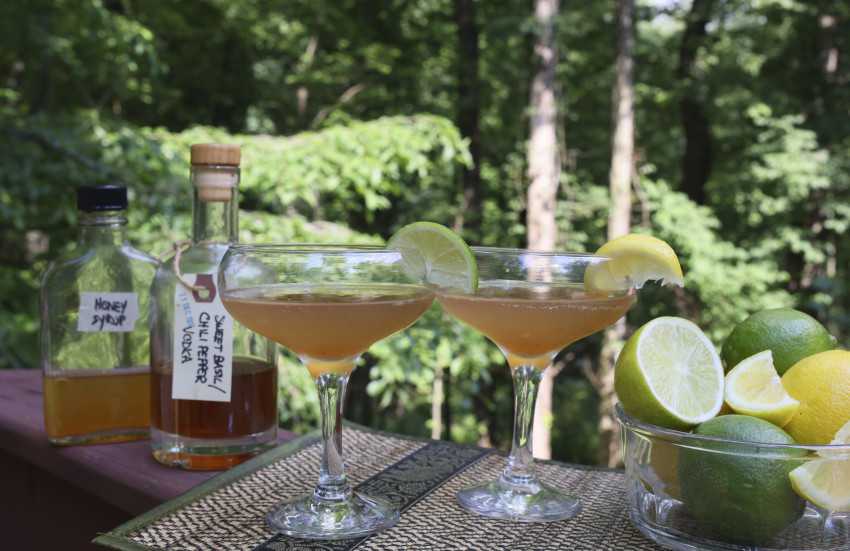Love infusions in your cocktails? Bring that skill home
11 July, 2021

A half-dozen Mason jars line the top shelf of Toni Dash’s pantry. Some are filled with clear liquid tinted almost imperceptibly. Others, like the jar of vodka infused with ripe pears and a generous helping of spices, are bursting with vivid colors that make cocktails as beautiful as they are delicious.
Dash is no professional bartender. She’s a recipe developer. But she discovered years ago that it was easy to make complex, delicious cocktails at home with little effort by infusing liquors with fruits, herbs, spices and even candy.
When you’re served a craft cocktail fresh off the latest menu, it’s easy to assume that making something similar at home would be difficult. But by layering additional flavors into your favorite gin or bourbon or vodka, you can build a collection of nuanced spirits that are ready for mixing at a moment’s notice.
The process is simple: Let the flavoring ingredient steep in alcohol for hours or days (or even weeks, if you’re creating something truly intense). Then strain those ingredients out and return the alcohol to its bottle, or store it in a Mason jar.
The range of possible ingredients is endless. Dash, who lives in Boulder, Colorado, and blogs at BoulderLocavore.com, has experimented with everything from dried goji berries to candy canes.
“My inspiration tends to be seasonal,” she says “But there just are no limits. If you think of it, try it.”
Here’s what’s fun about infusing, besides the drink you get at the end. It’s about mixing flavors. It’s about taking pieces of wisdom you might have picked up from cooking and applying them to mixology. And it’s about learning the subtleties of the natural world – which flavors complement each other and which collide hard.
Seasonal fruit inspired Josh Williams to begin infusing liquors more than a decade ago. He began steeping fresh summer peaches in bourbon during college, then kept honing the hobby when he moved to New York City in 2008.
Eric Prum, who runs the food and drink-focused W&P Design with Williams, remembers the reactions when Williams would strain his fruit-infused bourbon into jars and give it to friends. People were surprised that a process so simple could create a bespoke ingredient that made mixing complex cocktails at home much easier.
“It was mind-melting to people that you could take this thing that was really wonderful, like a great bourbon, and really elevate it,” says Prum, who years later teamed up with Williams to write the book “Infuse.”
Dash and Prum also recommend infusing syrups. Then you can build multi-layered cocktails easily: one infused liquor, one infused syrup and a bit of fresh juice.
During the past year’s on-and-off quarantines, Pittsburgh-based bartender Derek Ott says more people have begun attempting to make distinctive cocktails at home.
“They’re digging deep into being creative and finding out how they can replicate that syrup or that tincture or that infusion,” he says.
Home infusing can start with something as simple as a bottle of inexpensive bourbon and a cinnamon stick. Caraway seeds can intensify a basic bottle of rye. Cacao nibs can turn a liqueur into a multi-flavored dessert drink. And a handful of chili peppers and sweet basil can electrify any vodka.
Loose tea leaves or ground coffees are perhaps the easiest to add flavor to liquors or syrups — after all, they’re built to infuse into water already.
“I’ve done a strawberry-tomato-basil syrup,” Ott says. “You get the sweetness from the strawberry, but then you also get that acidic, vegetal taste from the tomato.” Basil's flavor works well with vodka or gin, he says, “and it plays well with lemon juice or grapefruit juice."
Not everything works well together. But if you’re infusing ingredients that you already have in your kitchen and you’re working in small batches, it’s inexpensive to experiment.
“I’ve just tried all this different stuff,” Dash says. “It’s usually good. Sometimes it’s not.”
Ott and Dash both suggest using mid-priced liquor brands. “Getting something less expensive makes sense,” Dash says, because your infusion will improve the taste. But for best results, avoid bottom-of-the-barrel spirits.
The result: something you might not have realized you could do on your own, and a horizon of cocktail possibilities just ahead.
Curious about trying an infusion of your own? Here are two basic recipes to get you started.
BOURBON INFUSED WITH COFFEE
Ingredients:
One regular-size bottle (750ml) bourbon
½ cup ground coffee of your choice (use flavored coffee for a more complex result)
Steps:
Pour the bourbon into a large Mason jar. Add coffee. Screw on cover and let steep for approximately four hours or to taste. (As with hot coffee, longer steeping time will result in stronger flavor.) Strain bourbon through cheesecloth or a fine mesh strainer. If necessary, strain multiple times to remove all coffee grounds. Pour into Mason jar or return to the bourbon’s original bottle.
SIMPLE SYRUP INFUSED WITH LAVENDER
Ingredients:
1 cup granulated sugar
1 cup water
1/2 cup dried lavender flowers (available at spice shops)
Steps:
Dissolve sugar in boiling water in saucepan. Remove from heat. Add lavender and let steep in the sugar syrup as it cools. Once cool, test flavor. When it’s strong enough, strain to remove the lavender. Transfer to a clean Mason jar or empty liquor bottle. Refrigerate for up to one month.
Source: www.thenationalnews.com
TAG(s):
